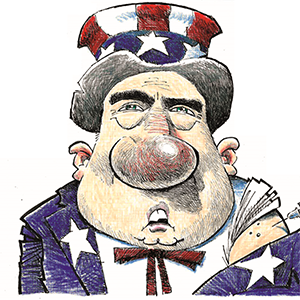Current News
/ArcaMax

Moonbound Artemis II astronauts stay focused despite NASA uncertainty
CAPE CANAVERAL, Fla. — It could be less than nine months before humanity ventures back to the moon, even if only to fly around it. The people set to make that flight were back on the Space Coast on Wednesday to log time with their ride, the Orion spacecraft.
First up, the crew of Artemis II with NASA astronauts Reid Wiseman, Victor Glover and...Read more
Richard Tillman now faces federal arson charge for San Jose post office attack
SAN JOSE, Calif. — A man charged locally with trying to destroy a South San Jose post office by driving a flaming car into the building — while livestreaming the entire ordeal, including his real-time police interrogation — now faces a federal arson charge for the alleged attack, according to the regional U.S. attorney’s office.
Richard...Read more

Trump eyes his Doral club in Florida for G20 summit
WASHINGTON — President Donald Trump plans to host next year’s Group of 20 summit at his Doral resort in Florida, and to cut the number of extra participants to narrow the gathering’s size, people familiar with the matter said.
Preliminary planning is underway with the United States set to take over as host country in 2026. No final ...Read more

Colorado lawmakers must close new budget gap -- reaching nearly $1 billion -- caused by Trump tax bill
Colorado lawmakers must immediately cut or find nearly $1 billion to fill a massive hole blown in the budget by the federal tax bill signed by President Donald Trump, state officials told legislative leadership Wednesday.
“It is significant, and every day we wait, the deeper the cuts we will have to make as we go through this,” said Mark ...Read more

Anti-DEI group's complaint against Duke in sync with Trump administration threats
When the Trump Administration accused Duke University of racist practices and threatened to pull federal funding this week, no specific allegations were made public.
Federal officials only said that “allegations have been brought” to their attention that, if credible, could “render Duke Health unfit for any further financial relationship ...Read more

Funeral for NYPD Officer Didarul Islam slain in Park Avenue mass shooting set for Thursday
Last week, NYPD Officer Didarul Islam thought he knew exactly where he and his family would be the following Wednesday: enjoying themselves at a New Jersey water park.
But instead of experiencing the fun-filled day with extended family members Islam’s two sons were so looking forward to, the family is planning the hero cop’s funeral.
“...Read more

Donor pulls $10 million gift to Miami Dade College over in-state tuition waivers
MIAMI — Weeks after rescinding a $1 million donation to Florida International University, Miami philanthropist Miguel “Mike” Fernandez is now withdrawing another $10 million from Miami Dade College — a direct response to Florida’s recent repeal of in-state tuition for undocumented students.
In a letter dated July 29 to MDC President ...Read more

Klobuchar brushes off Booker dustup, says they will 'continue to fight' Trump
WASHINGTON — Minnesota Sen. Amy Klobuchar on Wednesday shrugged off a Democratic dustup that spilled out into public view on the Senate floor this week, calling it “democracy in action.”
On Tuesday, Klobuchar and Nevada Sen. Catherine Cortez Masto clashed with New Jersey Democratic colleague Sen. Cory Booker after he blocked the approval ...Read more

Epstein grand jury transcripts sought by Trump DOJ may do little to quell the controversy: docs
The grand jury transcripts in Jeffrey Epstein’s and Ghislaine Maxwell’s criminal cases — which the Trump administration is trying to get unsealed in a bid to satisfy demands for more transparency — contain testimony from just two law enforcement witnesses that may do little to answer questions surrounding President Donald Trump’s role ...Read more

Canada plans to recognize Palestinian state, joining France, UK
VANCOUVER, Canada — Prime Minister Mark Carney said Canada plans to recognize a Palestinian state at the United Nations summit in September, following France while setting up a clash with the U.S. and Israel.
Carney said Canada’s long-favored approach of a two-state solution through a negotiated settlement between Israel and the Palestinian...Read more
North Carolina lawmakers enact law letting private schools arm teachers after defeating veto
RALEIGH, N.C. — A Republican bill allowing private schools to give teachers and volunteers permission to carry concealed guns on campus was enacted into law after lawmakers successfully defeated Democratic Gov. Josh Stein’s veto.
Stein’s veto of House Bill 193 was overridden in the House first on Tuesday morning. Republicans in that ...Read more

Trump hits India with 25% tariff, threatens more over Russia
President Donald Trump said he would impose a tariff of at least 25% on India’s exports to the U.S. starting Friday, though later added that the two sides were still in talks.
Trump on Wednesday said he made the decision because India has tariffs that are “among the highest in the World, and they have the most strenuous and obnoxious non-...Read more
News briefs
Democrats blast ‘politics of fear’ after Trump’s claims against Obama, top aides
Angling to move beyond the Jeffrey Epstein scandal, President Donald Trump has escalated his push to enact revenge on political foes with unfounded allegations of intelligence tampering against Barack Obama and top members of the 44th president’s ...Read more

Trump says US to impose 15% tariff on South Korean goods
SEOUL, South Korea — President Donald Trump said he reached a trade deal with South Korea that would impose a 15% tariff on its exports to the U.S. and see Seoul agree to $350 billion in US investments.
“We have agreed to a Tariff for South Korea of 15%. America will not be charged a Tariff,” Trump said in a post to his social media ...Read more

Army helicopter was flying too high in collision with passenger jet over DCA: NTSB
WASHINGTON — The U.S. Army helicopter involved in the midair collision over Ronald Reagan National Airport in January was flying higher than it was supposed to be when it crashed into an American Airlines flight that was about to land at the airport, investigators found.
A hearing on Wednesday investigating the accident found that the ...Read more

'We did our job': Idaho prosecutor justifies plea deal in Kohberger murder case
BOISE, Idaho — Just days after sentencing in the most closely watched and scrutinized case of Bill Thompson’s decades-long legal career, he acknowledged that prosecuting Bryan Kohberger, who pleaded guilty to murdering four University of Idaho students, might not have been possible if the killer had not left his DNA at the crime scene.
...Read more

Florida releases heavily blacked out Alligator Alcatraz hurricane plan
Florida emergency management officials released a heavily blacked-out disaster plan for the Alligator Alcatraz immigration detention center on Wednesday, just two days after saying they had no document detailing what the camp would do if threatened by a hurricane.
The 33-page draft plan appears to detail alternate facilities that could be used ...Read more

US Department of Education opens DEI probe into Duke Law Journal
The U.S. Department of Education has opened a civil rights probe into the Duke Law Journal after a conservative news outlet reported the academic publication factored law students’ racial and ethnic identities when selecting editors.
“In some, if not all, cases, select applicants were afforded the opportunity to be awarded extra points ...Read more

Haitians file class-action lawsuit to stop Trump administration from ending TPS
A group of Haitians with temporary protected status is challenging the Trump administration’s end of legal protections from deportation for nationals of Haiti.
The class-action lawsuit was filed by five beneficiaries of TPS on Wednesday in federal court in the District of Columbia. The suit argues that returning Haitians to a nation being ...Read more

Democrats blast 'politics of fear' after Trump's claims against Obama, top aides
Angling to move beyond the Jeffrey Epstein scandal, President Donald Trump has escalated his push to enact revenge on political foes with unfounded allegations of intelligence tampering against Barack Obama and top members of the 44th president’s administration — triggering new alarms from Democrats.
Michigan Sen. Gary Peters on Wednesday ...Read more
Popular Stories
- Fear of ICE raids is making heat intolerable for Southern California families
- Aland Etienne, lobby security guard in Park Avenue mass shooting, died trying to stop elevators, NYPD says
- Las Vegas mosquitoes test positive for West Nile virus, officials say
- Senate confirms former Trump personal attorney for lifetime post
- Park Avenue gunman Shane Tamura left second suicide note in Las Vegas home





